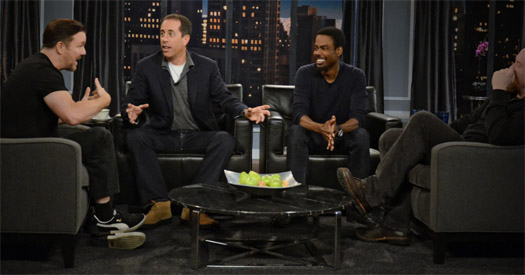
Several people called us about HBO’s hour-long special “Talking Funny” in which four great comedians — Ricky Gervais, Jerry Seinfeld, Chris Rock and Louis C.K. — talk shop for an hour. Our friends were all struck by how the “inside” of comedy echoes the process of making just about anything truly creative. Before we got to watch it, we found Michael Beirut‘s insightful post on Design Observer: Seven Things Designers Can Learn from Stand Up Comics. We’d change “Designer” to “Any Creative Person Who Is Trying to Make Something Great”; these 7 principles apply to way beyond comedy and design. We’ve printed the whole thing here, highlighted the essentials AND left it to you to fill in blanks. But it’s WORTH reading every word, especially Louis C.K.’s riff on the F word and Corvette’s in #4. Illuminating and really funny. (If you don’t get HBO, you can watch Talking Funny in 4 parts on YouTube. We also recommend Louis C.K.s beautiful ‘everything is so amazing, but nobody is happy’)
1. It’s all about the basics.
“I love jokes so much,” says Jerry Seinfeld towards the beginning of the show. “I love them so much.” He loves them because they’re the indestructible building blocks of comedy. The others agree. “So many of these young guys think it’s all attitude,” says Chris Rock. “But you have to have jokes under your weird persona, under your crazy glasses, under your crazy voice.” Design _____has basic building blocks too: scale, proportion, hierarchy, contrast. Get those right first. Or, as Seinfeld concludes: “You can put in all kinds of furniture, but you have to have steel in the walls.”
2. Once you’ve mastered the basics, make your work your own.
“Do you think you have to have a thing?” asks Ricky Gervais.”Well, you’ve gotta figure something out,” responds Seinfeld. Between all the “things” and “somethings,” we know exactly what they’re talking about. Every successful comedian is different. The best have an immediately identifiable attitude, whether it’s Henny Youngman, Demetri Martin, or the four participants in “Talking Funny.” The best designers are no different. Think of how many ways there are to design something like, say, a Vladimir Nabokov book cover. A good designer _____is a problem solver. A great designer _____can figure out a way to solve a problem that’s completely unique. At one point, Seinfeld tells a Louis C.K. joke his way, and asks, “Is that how it goes?” Louis CK replies, “Well, that’s a completely Seinfelded version. You made it…nice.” It’s one of my favorite parts of the show.
3. Respect your audience.
Chris Rock says: “A lot of comedians have great jokes, and they’re like, ‘Why is this not working?’ It’s not working because the audience doesn’t understand the premise. If I set this premise up right, this joke will always work.” The comics talk about ensuring the audience — so demanding, so easily distracted — is with them for every joke during the act. This doesn’t mean talking down or pandering. Rather, it’s good old-fashioned respect. I sometimes tell students that every design _____needs a welcome mat and a doorknob. The first helps a person realize, “Hey, this is for me.” The second gives them a way into the design _____. Good design _____, like good comedy, is about surprise. But surprise can’t happen in a vacuum. It needs a context that establishes familiarity. If you respect your audience, you provide that context.
4. Know your tools.
The tools of a stand up comic are words. Some [tools] are good for every job. Some are more powerful and should be used sparingly. All of them are potentially crutches. Louis C.K. says that Jerry Seinfeld once told him, “The F word is like a Corvette.” “And I thought,” says Louis C.K., “that means that it’s fast and it’s cool and it’s got power and thrust to it. But then I thought, wait a minute, this guy grew up on Long Island and collected Porsches. So to him, a Corvette is a piece of shit, with a Chevy engine, just a flashy bullshit car.” Your own favorite tool may be a typeface, or a Photoshop effect, or a certain color combination. Seinfeld says he stopped using the F word when he realized it had become a crutch. Of course, one man’s crutch is another man’s secret weapon. Or, as Louis C.K. observes, “Where I grew up, a Corvette is an awesome car.”
5. Honor your craft.
One striking running theme of “Talking Funny” is that each of the comics works extremely hard, creating challenges where they might just as easily coast. Chris Rock reinvents his entire show every year. Louis C.K. regularly takes his closing bit — the strongest part of his show — moves it to the beginning, and forces himself to create a new show designed to top the old climax. Ricky Gervais says, “Oh, it’s not just being funny. It’s being proud of your stuff and doing things that other people couldn’t do.” Louis C.K. adds that, for him, “Easy laughs, cheap laughs, they don’t exist.” Chris Rock: “How many unfunny comedians have ever sustained a career not being funny?” Mastery of craft is tied to perpetual self-improvement. And, just as in design _____, mere technique is never enough. Louis C.K. is nervous when he feels he’s relying on technical skill. “This bit is working because I know how to do stand up, not because it’s something that’s important to me.” Hone your skills, but make certain they serve ends that are important to you.
6. Don’t be afraid of failure.
Good comedians experiment constantly. Every time they test a new joke, they risk bombing. That’s why they’ll try out new material in smaller venues, polishing pieces in front of live audiences: they need to hear what’s working and what’s not working. Seinfeld admits that when he was starting out, “I was hitting 500. I would have a good show and a bad show, a good show and a bad show.” His very first show was bad. “But success wasn’t my objective.” He was desperate to simply be on stage, and was willing to risk failure every other night to get there. Designers take risks for the same reasons. Trying something new means not being sure of the outcome. But it’s the only way that anyone working in a creative field can hope to make progress. Ambition is a strong enough antidote to fear. Louis C.K. remembers how he idolized good comics: “I wanted to be one of them, and I didn’t care if I sucked at it.”
7. Finally, never forget you have a special gift.
Ricky Gervais, in a revealing moment, asks, “Don’t you ever think, when we make people have this feeling of laughter, and they pay us money: what if they discover they can do it themselves?” The other comics are rather stunned at this. Seinfeld shouts, “But they can do it themselves!” Gervais, almost glumly asks, “Then why are they paying us?” Louis C.K. answers, “We’re a high octane version of it. We’re pros. They can play touch football, too.” And Seinfeld adds: “But that doesn’t hurt the NFL.” We live at a time when the tools of design are more available than ever before. What client doesn’t have a nephew who knows InDesign, or, better still, a spouse with a newly discovered enthusiasm for Powerpoint? Graphic design: anyone can do it, right? Well, yes. But the professionals still understand what it means to do something well. And that confidence makes its own statement.
Near the end of the show, Chris Rock talks about what a pleasure it is to watch anyone do anything really well, even a great truck driver. “I just saw this guy park an 18-wheeler into this narrow space,” he says. “And I said I guarantee you there’s heart surgery that’s not as hard as what this guy just did.” Louis agreed. “I watched a guy pull into a loading dock, and I stopped and said, ‘That was amazing.’ And he was like, ‘Yeah, I know, I know.’” If you’re a designer, it’s easy to forget that what you do is, in so many ways, amazing. Appreciate that gift in yourself. Appreciate the gifts of others. And look for lessons wherever you can find them.
via Design Observer
share this


















